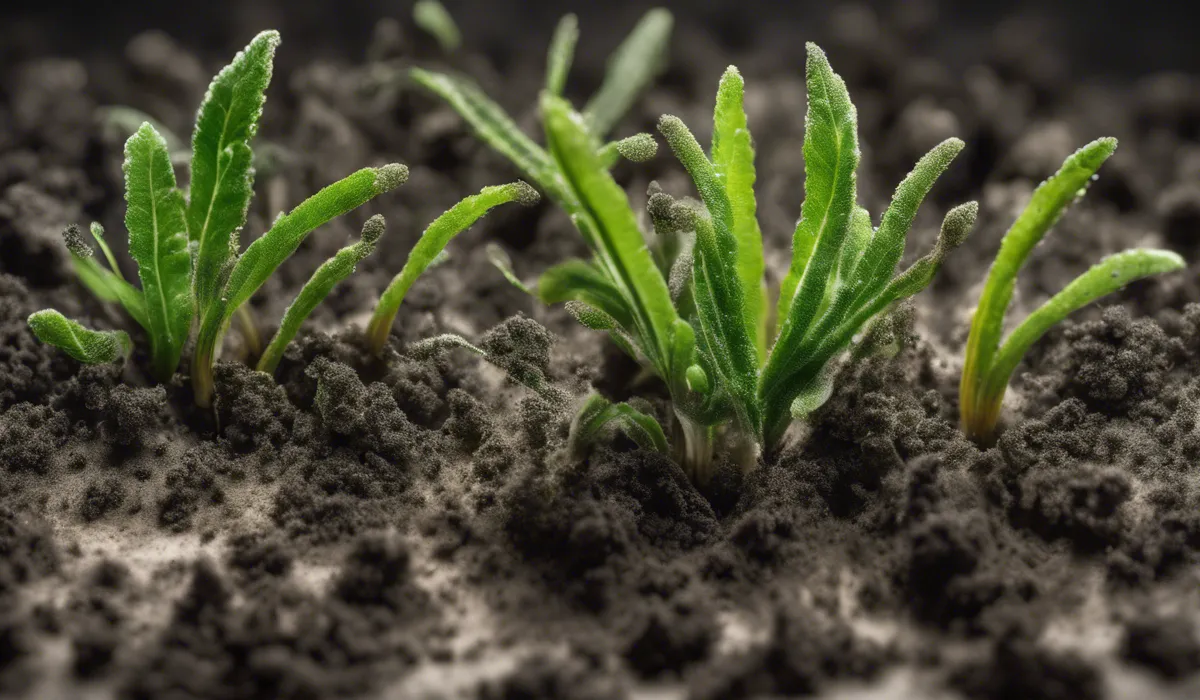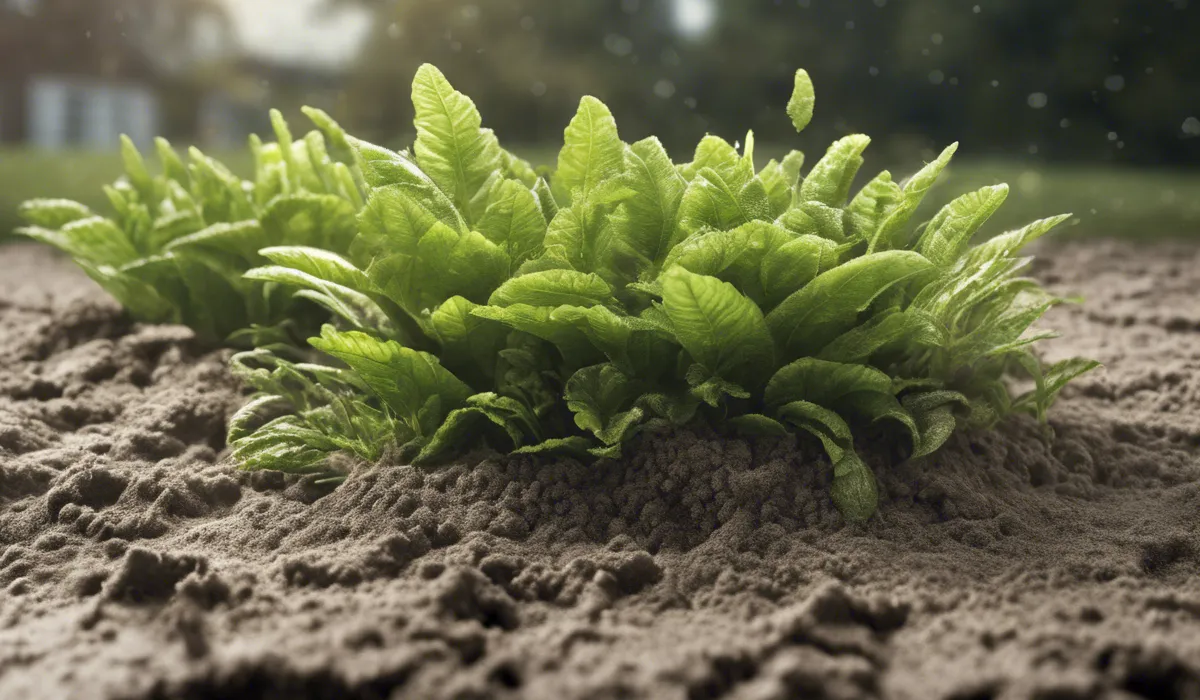To eliminate mold on plant soil, reduce watering to let the soil dry out, scrape off the mold, increase air circulation around the plant, and expose the soil to sunlight. If necessary, repot with fresh soil.
Identify the Presence of Mold

Types of Mold on Plant Soil
Mold on plant soil can appear in various colors and textures. White mold often looks like a fuzzy substance that can cover the soil surface.
It is one of the most common types of mold found in overwatered plants. Green mold may resemble the algae you see in ponds and is another sign of excessive moisture.
Black mold, while less common, is usually indicative of a more severe problem and can be associated with soil that is not only wet but also poorly ventilated.
Each type of mold has its unique characteristics, but all are unwelcome guests in your potted plants.
Conditions Fostering Mold Growth
Mold thrives in conditions where there is high humidity and poor air circulation. Overwatering your plants creates an ideal environment for mold to grow.
Additionally, lack of proper drainage can lead to water pooling at the bottom of the pot, further encouraging mold development.
Indoor plants may also be at risk if the room’s air is stagnant or if they are placed in areas without sufficient natural light.
Recognizing Mold on Your Plant Soil
Identifying mold begins with noticing changes in the top layer of your plant’s soil. If you see a white, green, or black layer that was not there before, it is likely mold.
The presence of a musty smell can also indicate that mold is growing. In some cases, you may notice that your plant is not growing as well as it should be, which can be a sign that mold is affecting the health of the soil and roots.
Preventive Measures

Mastering Watering Techniques
The key to preventing mold is to water your plants correctly. Ensure the top layer of soil is dry to the touch before watering again.
Use a watering can with a long spout to target the roots directly, avoiding excessive moisture on the surface where mold can grow.
It is also helpful to understand the specific watering needs of each plant, as some require more water than others.
Ensuring Good Air Circulation
Good air circulation is crucial in preventing mold growth. Make sure your plants are not crowded together, as this can restrict air flow.
If possible, use a small fan to keep the air moving, especially in areas with little natural airflow. Regularly pruning your plants can also help air reach the soil and reduce humidity levels around the foliage.
Selecting the Right Pot and Soil
The type of pot and soil you choose can greatly impact mold growth. Pots with drainage holes allow excess water to escape, which is essential for preventing mold.
Additionally, using a soil mix that is well-draining can help ensure that water does not accumulate around the roots. Consider adding perlite or sand to your soil mix to improve drainage.
Cleaning and Maintenance Routines
Regularly cleaning your plant containers can help prevent mold spores from taking hold. Wipe down the outside of pots to remove any dirt or debris.
Additionally, removing dead leaves and spent blooms from the soil surface can reduce the organic matter that mold feeds on. A clean environment is less inviting to mold growth.
Mold Removal Strategies

Manual Mold Removal
If you spot mold on the soil, gently scrape it off the surface. This immediate action can prevent the mold from spreading.
Be sure to dispose of the removed mold far from your plants to avoid reinfection. In some cases, you may need to remove the top layer of soil and replace it with fresh, sterile soil.
Utilizing Sunlight
Exposing your plant’s soil to sunlight can help kill mold spores. If possible, place your plant outside in a sunny spot for a few hours, or in a well-lit room where sunlight can reach the soil.
Sunlight is a natural disinfectant and can help dry out the excess moisture that mold needs to thrive.
Natural Remedies for Mold
Natural remedies can be effective in treating mold without the use of harsh chemicals. Sprinkling cinnamon on the soil surface is a natural fungicide that can prevent mold growth.
Apple cider vinegar diluted with water can be sprayed on the soil to kill mold spores. Chamomile tea, when cooled and used to water plants, can also help prevent fungal diseases.
When to Use Chemical Fungicides?
If natural remedies do not work and the mold problem persists, you may need to resort to chemical fungicides.
It is important to use these products as a last resort and follow the directions carefully.
Always wear protective gear when applying fungicides and avoid using them on edible plants. Choose products that are safe for indoor use and make sure to ventilate the area well.
Repotting with Fresh Soil
If mold has severely affected the soil, repotting your plant may be necessary. Carefully remove the plant from its current pot and gently shake off the moldy soil.
Clean the roots with water, and then repot the plant in fresh, sterile soil. Clean the pot thoroughly before reuse, or consider using a new pot to avoid reinfection.
FAQs About Getting Rid of Mold on Plant Soil
How can I prevent mold from growing on my plant soil?
To prevent mold growth, ensure proper drainage, avoid overwatering, and provide adequate air circulation for your plants.
What should I do if I find mold on my plant soil?
Scrape off the moldy top layer of soil, let the soil dry out by reducing watering, and increase air flow around the plant.
Is it necessary to expose moldy plant soil to sunlight?
Yes, exposing the soil to sunlight can help kill mold spores and prevent mold from spreading.
Can repotting help get rid of mold on plant soil?
Repotting with fresh, sterile soil can eliminate existing mold and give the plant a healthier environment.
What are some signs that my plant soil has mold?
Visible white, green, or black fuzzy or powdery growths on the surface of the soil are signs of mold.
Final Thoughts
To combat mold on plant soil, moderation in watering is key to allow drying. Mold can be removed manually, and airflow should be enhanced to prevent stagnation.
Sunlight exposure also helps in soil sterilization. Persistent issues might necessitate repotting with sterile soil to ensure plant health and mold eradication.
